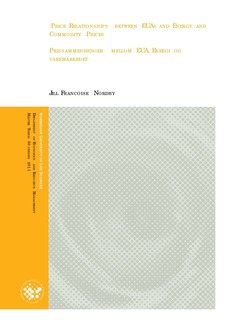| dc.description.abstract | This thesis concentrates on relationships between EUA prices and the European and Scandinavian electricity markets, as well as oil and commodity prices. The main purpose of the paper is to explore what relationships exist between these both in the short and the long term. Are there any significant connections between the markets, and does one affect the other or vice versa, and do they move together in the long term?
This type of exploration is interesting because of the nature of the EU ETS, a highly regulated market governed by national requirements. Politics is an important factor in both the trade and pricing of EUAs, and the market is especially interesting as Phase I saw a collapse of the system. Phase II, starting in 2008, has seen a rebirth in trade as well as a number of turbulent events, making the market an interesting and unpredictable one. The analyses in this thesis attempts to find connections in the data. The strong connection between electricity and oil and emissions, and how commodity production is related to oil prices suggests a relationship between these which this thesis explores and attempts to uncover.
Short-term relationships are explored for the period from 26.02.2008 to 01.04.2011, the start of Phase II of trade. This analysis does not uncover any evidence of oil or commodity prices having a significant effect on movements in EUA prices, but we can see that both European and Scandinavian electricity prices may have an explanatory value on them. In all cases, there are signals that the EUA price is affected by its own earlier movements. In reverse, there is no evidence that EUA prices have an effect on electricity, oil or commodity prices, but that oil prices as well as electricity traded on NordPool show evidence of being affected by their own previous movements. The long-term analysis uses cointegration tests to test for long-term relationships between the markets. In order to test for cointegration, there must be no evidence of stationarity, the tests for which did not show any evidence of this. Then, the residuals of regressions between EUAs and electricity, oil and commodity markets are tested for stationarity, indicating cointegration. No evidence of long-term relationships was found here. Then, spreads between EUAs and electricity, oil and commodity markets are tested for stationarity and cointegration, and the only relationships here were found between the spreads in ln EUA prices and ln oil and ln commodity prices, indicating that these move similarly in the long term. An event study is included in order to see whether or not three specific news events have had a noteworthy effect on not only the EUA market, but also related markets. First, the hacking scandal where CO2 quotas were stolen digitally shows evidence of not only shaking the EUA market, but also the European electricity market. Second, the dramatic increase in oil prices during the spring of 2011 shows evidence of similar but delayed effects on the EUA market, with more extreme reactions to a drop in oil prices than an increase in oil prices. The final event explored in the event analysis is the earthquake in Japan in March 2011, which sparked a reaction in Europe in the form of the decision to close numerous nuclear power plants with immediate and more long-term effect. The announcement of this decision in Europe naturally sparked a great reaction in the European electricity price, causing a dramatic increase from the day of the announcement. In regards to EUA prices, there is evidence of a more gradual increase in prices in the days following the announcement, but again a jump can be seen around a month later, indicating a delayed reaction to the increase in European electricity prices.
Although the empirical analyses do not indicate any relationship between either electricity, oil or commodity markets and the EUA market, the event study still displays some evidence that shocks in European electricity as well as the oil market will lead to a delayed shock in the EUA market, with varying effects. | no_NO |
